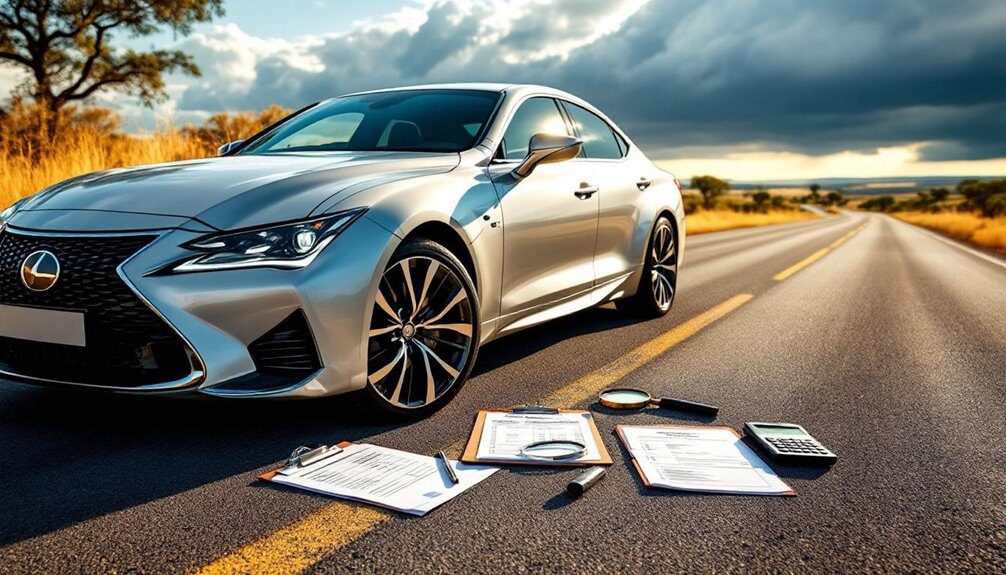When buying a pre-owned car in South Africa, it's crucial to understand warranty options and your rights as a buyer. Carefully review dealer disclosure information and inspect the vehicle in daylight for signs of damage.
Be aware of wear-and-tear levels and distinguish between defects and wear. Know your return policy rights and consider extending your warranty for financial security.
Efficiently resolve car disputes and obtain all relevant documentation when purchasing. By following these tips, you'll be well-prepared to navigate the pre-owned car market.
Review Dealer Disclosure Information
When purchasing a pre-owned vehicle in South Africa, meticulously reviewing the dealer's disclosure information is crucial because it provides valuable insights into the car's history and condition, thereby building trust between the buyer and seller. This transparency is vital in ensuring that buyers are well-informed about the vehicle's condition, which in turn enables them to make an informed decision.
Dealers in South Africa are legally required to disclose known faults, reconditioning details, and the car's initial registration year, guaranteeing that buyers are aware of the vehicle's condition. For instance, if a car has been in an accident, the dealer must disclose this information, allowing the buyer to factor this into their decision. This transparency also implies a certain level of warranty coverage, with older cars being sold as scrap and coming with a 6-month warranty for the buyer.
A thorough inspection process is crucial to identify any potential issues, and buyers should carefully review the disclosure requirements to ensure they are getting a fair deal. It is recommended that buyers inspect the vehicle in daylight, looking for any signs of damage or wear and tear. By doing so, buyers can make an informed decision and avoid potential pitfalls, such as buying a car with hidden faults.
Understand Wear-and-Tear Levels
In South Africa, grasping wear-and-tear levels is crucial when purchasing a pre-owned vehicle, as it significantly affects the buyer's rights and obligations. A thorough understanding of wear-and-tear levels enables buyers to distinguish between acceptable wear and actual defects, which can be a decisive factor in resolving warranty disputes.
Prior to signing the sales agreement, it is essential to acknowledge the vehicle's wear-and-tear levels, as this forms part of the purchase agreement. Failure to do so may result in disputes arising from misunderstandings about the vehicle's condition. Therefore, it is vital to carefully inspect the vehicle and negotiate with the seller if necessary.
A comprehensive wear assessment is critical in determining the vehicle's condition and what is deemed acceptable. For instance, minor scratches on the exterior or worn-out floor mats may be considered acceptable wear-and-tear, whereas faulty brakes or transmission issues would be classified as defects. A thorough assessment helps buyers identify potential issues and plan accordingly.
Understanding what constitutes acceptable wear-and-tear levels is vital, as it directly impacts the buyer's rights and obligations. For example, if a buyer purchases a vehicle with worn-out tyres, they cannot claim a warranty on the grounds of tyre wear. In the event of a dispute, resolving wear-and-tear issues typically takes around three months, so it is crucial to be aware of the process and plan accordingly.
Know Your Return Policy Rights
Acquiring knowledge of wear-and-tear levels is crucial because it empowers buyers to make informed decisions, but it's only half the battle. Equally important is understanding return policy rights under the Consumer Protection Act, which guarantees a smooth resolution of any issues that may arise with their pre-owned car purchase. This knowledge enables buyers to navigate the process of resolving issues confidently and efficiently.
In South Africa, the Consumer Protection Act affords buyers the right to return a used car within six months if it fails to meet the expected quality standards. This return policy allows for options such as repair, replacement, or refund of the purchased vehicle if it's deemed defective or unsuitable for its intended purpose. For instance, if a buyer discovers that the car's engine is faulty, they can request a repair, replacement, or a full refund within the six-month timeframe.
| Return Policy Options | Description |
|---|---|
| Repair | The seller will fix the defects or issues with the vehicle, ensuring it meets the expected quality standards. |
| Replacement | The seller will provide a similar vehicle or a full refund, giving buyers a suitable alternative. |
| Refund | The seller will refund the full purchase price, allowing buyers to explore other options. |
Understanding return policy rights is vital because it protects buyers from being stuck with a defective vehicle. By documenting any defects or issues with the car, buyers can strengthen their case for utilising the return policy rights within the specified timeframe. This legal protection ensures buyers are not left with a lemon, and they can enjoy warranty coverage with peace of mind. For example, if a buyer discovers a faulty transmission, they can use their return policy rights to request a repair or replacement, ensuring they get a reliable vehicle.
Differentiate Between Defects and Wear
Understanding the nuances between defects and wear is crucial when navigating pre-owned car warranties in South Africa, as it directly impacts your rights as a consumer under the Consumer Protection Act. Failing to distinguish between the two can lead to disputes with dealerships, financial losses, and a poor overall buying experience.
Defects are faults that render the car unsafe, not of good quality, or unsuitable for its intended purpose, such as faulty brakes or a malfunctioning airbag. In contrast, wear refers to the normal deterioration of a vehicle's components over time, which is expected in used cars, like worn-out tyres or a faded paint job.
When inspecting a pre-owned vehicle, it's essential to identify defects to determine if the car falls under the implied 6-month warranty period for repairs, replacements, or refunds. For instance, if a car's engine light is on, indicating a faulty oxygen sensor, it would be considered a defect. Conversely, worn-out floor mats would be classified as wear.
Knowing how to differentiate between defects and wear can help you navigate pre-owned car warranties, protect your rights as a consumer in South Africa, and ensure you're not held responsible for repairs or maintenance that should be covered by the warranty. This knowledge can save you thousands of rands and provide peace of mind when purchasing a pre-owned vehicle.
Extend Your Warranty Options
As you consider extending your warranty, it's crucial to understand the options available to you.
In this section, we'll investigate the different ways to improve your warranty, including upgrade options, extended coverage benefits, and additional protection plans.
Warranty Upgrade Options
When purchasing a pre-owned vehicle in South Africa, buyers have the opportunity to extend their aftermarket warranty, thereby safeguarding themselves against unforeseen repair costs and mechanical failures that may arise beyond the original warranty period. This extended protection provides peace of mind and financial security, covering unexpected repair costs on pre-owned vehicles.
To make the most of this option, it is crucial to research and compare different extended warranty providers to find the best fit for your needs and budget. For instance, some providers may offer more comprehensive coverage, while others may have more flexible pricing options. Comparing providers will help you find the one that suits your specific requirements.
It is essential to ensure that the extended warranty offers flexible coverage options to cater to your specific requirements. For example, some warranties may offer mileage-based coverage, while others may provide coverage for a specific period. Having flexible coverage options ensures that you are protected against unforeseen repair costs, regardless of your vehicle's usage.
Opting for a reputable warranty provider with a proven track record of honoring claims and providing excellent customer service is vital. A reputable provider will have a strong customer service team to assist with any claims or queries, giving you peace of mind and minimising downtime in the event of a mechanical failure. For instance, a provider like Motorite Admin offers a comprehensive warranty programme with a 24-hour claims service.
It is crucial to weigh the cost of the extended warranty against the potential benefits, ensuring it's a worthwhile investment for your pre-owned vehicle. Consider the cost of the extended warranty as a small price to pay for the peace of mind and financial security it provides. Additionally, an extended warranty can increase the resale value of your vehicle, making it a worthwhile investment in the long run.
Extended Coverage Benefits
Extended warranty coverage is crucial for pre-owned car owners in South Africa, as it provides numerous benefits that significantly enhance their overall ownership experience. By investing in an extended warranty, owners can avoid the financial burden of unexpected repair costs, which can be substantial and even lead to financial distress. For instance, a study revealed that the average repair cost for a pre-owned vehicle in South Africa can range from R5,000 to R20,000, depending on the make and model.
One of the most significant advantages of extended warranty coverage is the inclusion of emergency services, such as roadside assistance and towing services. This comprehensive coverage ensures that owners are never stranded on the side of the road, reducing the stress and anxiety associated with car ownership. For example, the Motorite Extended Warranty provides 24/7 roadside assistance, including towing, fuel delivery, and lockout services, giving owners peace of mind while on the road.
Additional Protection Plans
Protection from unforeseen repair costs can be further bolstered by additional protection plans, which offer pre-owned car buyers in South Africa a range of extended warranty options to suit their unique needs and budgets. This is particularly important as it provides peace of mind and financial protection against unexpected mechanical failures, allowing car owners to budget more accurately and avoid financial strain.
When considering additional protection plans, it's essential to compare pricing options from different providers to find the best value for your money. Failing to do so can result in overpaying for a plan that may not provide adequate coverage. For instance, a provider like Motorite offers a range of extended warranty options with varying levels of coverage, making it crucial to research and compare prices before making a decision.
It is also vital to review warranty coverage carefully, as the terms and conditions can significantly impact the level of protection offered. The coverage limits, exclusions, and claim procedures must be thoroughly understood to avoid any unexpected surprises. For example, some plans may not cover certain components or repairs, so it's essential to review the fine print before committing to a plan.
Understanding contract terms is another critical aspect of selecting an additional protection plan. The duration, mileage limits, and conditions that may void the warranty must be clearly understood to ensure the plan remains valid. Failure to comply with these terms can result in the warranty being invalidated, leaving the car owner without protection. A reputable provider like AutoCorp, for instance, offers flexible contract terms that cater to different needs and budgets.
Resolve Car Disputes Efficiently
Prompt resolution of disputes is crucial in maintaining trust and confidence in the motor industry. This is because unresolved disputes can lead to a breakdown in the relationship between dealerships and consumers, ultimately affecting the reputation of the industry as a whole. MIOSA's efficient conflict resolution process helps to prevent this by providing a quick and fair process for resolving disputes.
The dispute resolution process is straightforward and efficient. Firstly, you submit your complaint to MIOSA, and our team will review your case and conduct a legal and technical assessment. If necessary, a technician will be dispatched to inspect the vehicle. This thorough process ensures that all aspects of the dispute are considered, and a fair resolution is reached.
MIOSA's role is to provide a neutral and impartial platform for dealerships and consumers to resolve disputes. Our team ensures that all parties are treated fairly and that the dispute is resolved promptly. In fact, we aim to resolve disputes within 30 business days from receiving all necessary documentation. This efficient process gives you peace of mind when purchasing a pre-owned car with a warranty.
For example, if you purchase a pre-owned car with a warranty and discover a fault that is not resolved by the dealership, MIOSA can step in to facilitate a resolution. Our team will review your case, inspect the vehicle if necessary, and work with the dealership to reach a fair resolution. With MIOSA, you can trust that your dispute will be handled promptly and fairly, giving you confidence in your purchase.
Receive All Relevant Documentation
When purchasing a pre-owned car with a warranty, receiving all relevant documentation is crucial to ensure a smooth and informed transaction. This is because having access to these documents allows you to make an informed decision, avoiding potential pitfalls and protecting your rights under the Consumer Protection Act.
Furthermore, it enables you to verify the car's history, ensuring you're not inheriting someone else's problems.
Requesting service records is essential, as it allows you to verify the car's maintenance history, including any routine servicing, repairs, or replacements. This information is vital in determining the car's overall condition and can significantly impact its resale value. For instance, a car with a full service history can retain up to 10% more of its value compared to one with incomplete records.
Understanding the warranty information is also vital, as it outlines the coverage, including what's included and the expiration date. This information can help you plan for future maintenance costs and avoid unexpected expenses. For example, if the warranty covers repairs for parts and labour, you can budget accordingly, avoiding surprise costs.
Knowing the car's ownership history is equally important, as it can reveal any previous accidents, damage, or major repairs. This information can significantly impact the car's value and your decision to purchase. By requesting ownership history reports from services like HPI or Experian, you can uncover any hidden issues and make an informed decision.
Lastly, requesting repair and modification records can provide valuable insights into the car's condition. These records can reveal any customisations, aftermarket installations, or previous repairs, which can affect the car's performance, safety, and value. By reviewing these records, you can identify potential issues and negotiate a better price or walk away from the deal if necessary.
Remember to sign a receipt for all documentation received to ensure transparency and clarity in the transaction. This protects both you and the seller, providing a clear paper trail in case of disputes.
Conclusion
Top 7 Tips for Pre-Owned Car Warranties in South Africa
When purchasing a pre-owned vehicle in South Africa, understanding the warranty terms is crucial to avoid costly surprises. By being aware of the following key tips, buyers can make informed decisions and guarantee a smooth ownership experience.
1. Review Dealer Disclosure Information
Before signing any agreements, carefully examine the dealer's disclosure statement. This document outlines the vehicle's history, including any existing damage or required repairs. Confirm all information is accurate and complete to prevent potential disputes.
2. Understand Wear-and-Tear Levels
Familiarise yourself with the vehicle's wear-and-tear levels, as they impact the warranty's validity. Be mindful of the acceptable levels of wear on parts like tyres, brake pads, and battery life to prevent disputes during claims.
3. Know Your Return Policy Rights
Comprehend the return policy and the process for returning a defective vehicle. Be mindful of the timeframe for returns, as well as any associated costs or penalties.
4. Differentiate Between Defects and Wear
It is vital to distinguish between manufacturing defects and wear-and-tear issues. This differentiation will help determine the warranty's applicability and prevent unnecessary disputes.
5. Extend Your Warranty Options
Consider expanding your warranty options to ensure continued protection beyond the standard warranty period. This can provide peace of mind and financial security.
6. Resolve Car Disputes Efficiently
In the event of a dispute, know the process for resolving issues effectively. Keep detailed records of all communication and ensure that all parties are aware of their responsibilities.
7. Receive All Relevant Documentation
Ensure all necessary documentation, including the warranty agreement, is provided and understood. Keep these documents in a safe and accessible location for future reference.
In summary, a thorough grasp of pre-owned car warranties in South Africa is fundamental for a hassle-free ownership experience. By following these seven key tips, buyers can make informed decisions and avoid costly surprises.
At Autobahn Motors, we understand the importance of smooth car ownership. If you have any questions about Used Cars, Car Services, Auto Repairs, Tyre Services, Car Parts, or Car Financing, we invite you to contact us to learn more.




